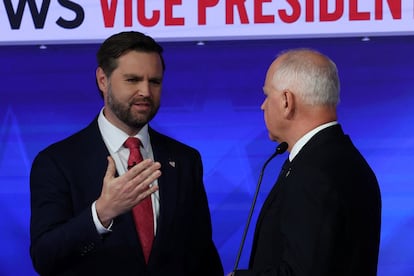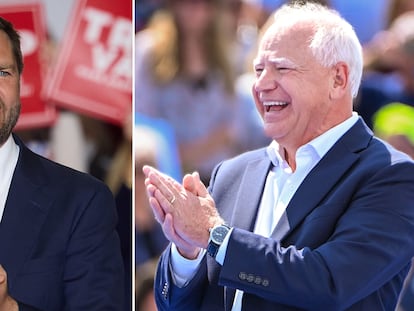Key takeaways from the VP debate between Tim Walz and J. D. Vance
The face-to-face between the vice-presidential candidates was a departure from the extreme polarization that has marked all of Donald Trump’s debates


The debate between the vice-presidential candidates, Republican J. D. Vance and Democrat Tim Walz, was the last big event on the agenda for the November 5 presidential election campaign. There are no more debates planned between the presidential candidates, Donald Trump and Kamala Harris, nor any other duel between the two protagonists who squared off Tuesday. The campaign will move forward along the paths of rallies, interviews, press conferences, television advertisements and — perhaps — unexpected surprises. Will the debate in New York move the voters? It is difficult to determine. It was a white-glove confrontation in which the two contenders targeted the presidential candidates rather than each other. Vance redeemed himself after his gaffes and campaign-trail mistakes. Walz struggled to convey the authenticity that is assumed of him. There was not a clear winner as in previous duels. Both candidates showed that there is a way of practicing politics beyond the extremism and polarization with which Trump has flooded the American political scene.
1. Attacks on Trump and Harris
Both Minnesota Governor Walz and Ohio Senator Vance were aware that the candidate to beat was not the one standing a few feet away on the other side of the CBS studio stage in New York. Walz attacked Trump for his policies as president and for his inability to democratically accept his 2020 defeat. Vance hammered at the economic results of Joe Biden and Kamala Harris’s term in office regarding inflation and immigration. Both defended their bosses. There were barely any cross-attacks between the two candidates: on the contrary, they displayed understanding and even empathy.
2. Vance vindicates himself
The Republican vice-presidential candidate had started his campaign on the wrong foot. He made several mistakes, the newspaper archives betrayed him, and at various campaign events he had seemed unnatural and uncomfortable in his interaction with voters. During the debate, however, he repeatedly appealed to his personal story, that of a boy from a poor family who made his own way despite the obstacles. He spoke about his wife, his children, his mother... He had it well-prepared, to the extent that he started with that refrain from the very first question, even though it was unrelated. But it reaped good results. The senator has the gift of the gab, he is good on camera, he addressed the moderators by their names, he showed empathy with his rival and he did not fall into any traps. As expectations had been low, he emerged galvanized.
3. A less authentic Walz than expected
The opposite was the case with the Democratic governor. He is a candidate who went into the debate with a halo of authenticity, the guy who helps you fix your car, the high school coach, the average American that most voters identify with. He entered the campaign on a strong footing, fired up the masses at early rallies and challenged Vance from a distance. However, he struggled to convey that authentic image. He was forced to acknowledge that he “misspoke” when he said he had been in China at the time of the Tiananmen Square protests. He did not make the same effort as his rival to present himself to Americans.
4. No dogs or cats, but Trump in the shadows
In political debates there is always some manipulated or selected data, some decontextualized statement and some exaggeration, but what Trump is used to is a chain of lies and nonsense without rhyme or reason. In the debate with Joe Biden, the fact-checkers were kept busy during Trump’s interventions, even if the current president’s meltdown overshadowed his opponent’s excesses. In the one-on-one with Harris, Trump’s responses reached paroxysm and provoked the moderators to correct some of his most outlandish statements. For example, that immigrants eat pets in Springfield (Ohio), or that there are states that not only allow late-term abortions, but even kill children after birth. In the debate between Walz and Vance there was nothing similar. Even so, via his social network, Trump was a commentator and insisted without any basis that there are states where “murdering babies” is allowed.
5. No clear winner and no clear effect
Even though Vance exceeded expectations and Walz struggled to convey authenticity, there was no clear winner as there was in the two previous debates, in which Trump beat Biden and Harris defeated Trump. Both vice-presidential candidates are good speakers and each presented their messages, which are opposed on many issues. Vance prevailed on the economy, but Walz cornered him in the final exchanges when the assault on the Capitol and the threat to democracy were discussed. The debate between the presidential candidates on September 10 barely moved the polls. It is difficult to see the vice-presidential debate doing so either.
Sign up for our weekly newsletter to get more English-language news coverage from EL PAÍS USA Edition
Tu suscripción se está usando en otro dispositivo
¿Quieres añadir otro usuario a tu suscripción?
Si continúas leyendo en este dispositivo, no se podrá leer en el otro.
FlechaTu suscripción se está usando en otro dispositivo y solo puedes acceder a EL PAÍS desde un dispositivo a la vez.
Si quieres compartir tu cuenta, cambia tu suscripción a la modalidad Premium, así podrás añadir otro usuario. Cada uno accederá con su propia cuenta de email, lo que os permitirá personalizar vuestra experiencia en EL PAÍS.
¿Tienes una suscripción de empresa? Accede aquí para contratar más cuentas.
En el caso de no saber quién está usando tu cuenta, te recomendamos cambiar tu contraseña aquí.
Si decides continuar compartiendo tu cuenta, este mensaje se mostrará en tu dispositivo y en el de la otra persona que está usando tu cuenta de forma indefinida, afectando a tu experiencia de lectura. Puedes consultar aquí los términos y condiciones de la suscripción digital.
More information
Archived In
Últimas noticias
Raúl Rocha, from jet-setting with Miss Universe to arms trafficking and fuel theft
80,000 barrels of Mexican oil sent to Cuba: Havana drawn into the US–Mexico clash
Human rights activists, opposition members, and a minor: Maduro’s other political prisoners
Israel sparks a civil war within the MAGA movement
Most viewed
- Reinhard Genzel, Nobel laureate in physics: ‘One-minute videos will never give you the truth’
- Pablo Escobar’s hippos: A serious environmental problem, 40 years on
- Charles Dubouloz, mountaineering star, retires at 36 with a farewell tour inspired by Walter Bonatti
- Why we lost the habit of sleeping in two segments and how that changed our sense of time
- The fall of a prolific science journal exposes the billion-dollar profits of scientific publishing










































